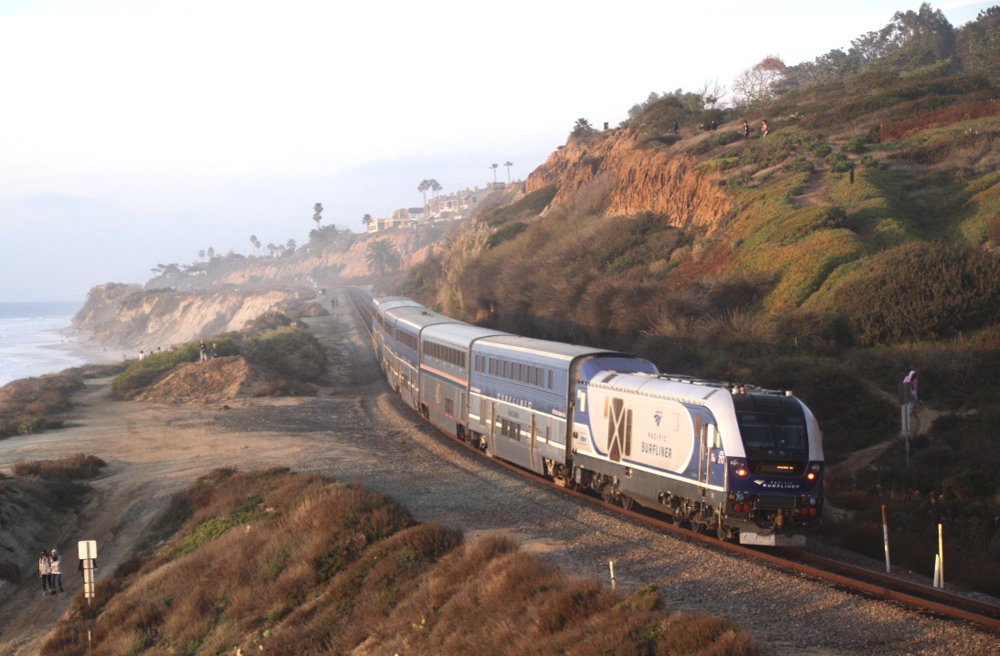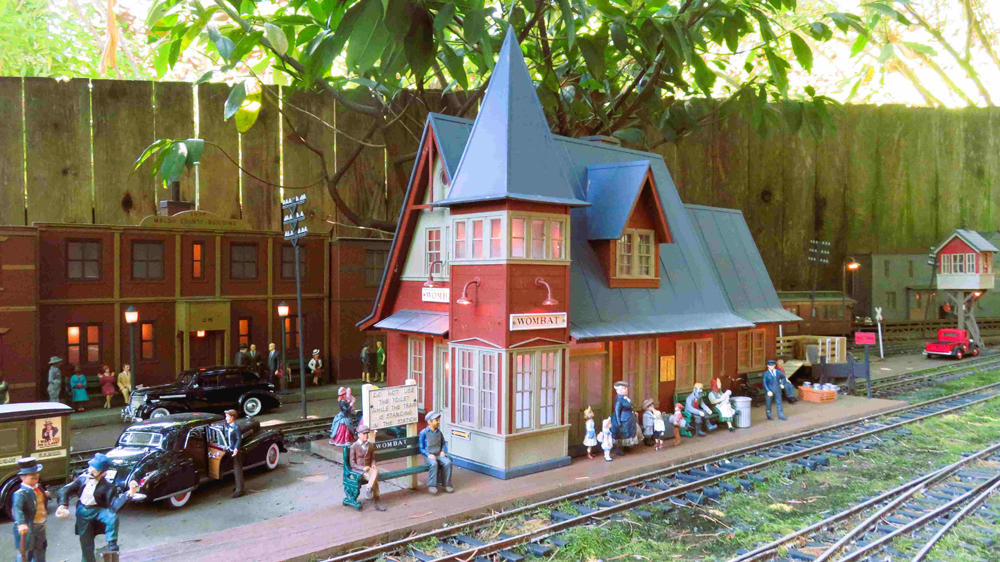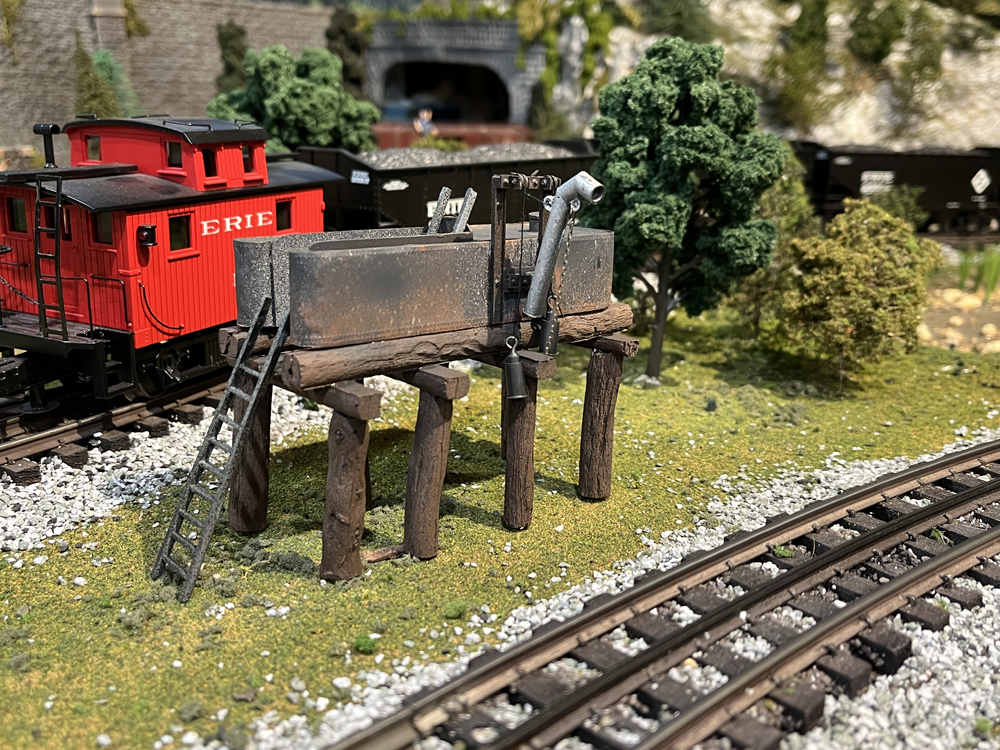
SAN DIEGO — The San Diego area will receive $300 million from the new California state budget for a plan to relocate the Surf Line inland from the Del Mar bluffs, a contribution a regional official called “a critical down payment” on a project estimated to cost $2.5 billion or more.
The San Diego Union-Tribune reports the proposal would move the former Santa Fe rail line inland about a mile, into a tunnel about 80 feet underground. The route is currently owned by the North Country Transit District and used by Coaster commuter trains, Amtrak Pacific Surfliners, and BNSF freight trains. The $300 million will go to the San Diego Association of Governments, the regional group which is the transit district’s parent, and will allow it to compete for federal matching funds for the project.
“We have talked for years about moving the rail tracks off the Del Mar Bluffs, and with this funding, we can now do it,” SANDAG Executive Director Hansan Ikhrata told the Union-Tribune. He said the project could break ground within three years and be done by the end of the decade, pending environmental review.
More information on the relocation project is included in this PowerPoint presentation.
Erosion of the Del Mar Bluffs remains an ongoing issue for the rail line. A three-year, $68 million plan to use a seawall and pilings to stabilize the bluffs — the latest in a series of stabilization measures — was approved in June [see “Stabilization plan to protect rail line on Del Mar Bluffs is approved,” Trains News Wire, June 9, 2022]. And the NCTD has been engaged in a long-running battle with the City of Del Mar and the California Coastal Commission over its plan to install a safety fence along the bluffs to prevent trespassing, a matter currently pending before the Surface Transportation Board.









Also need a tunnel through the canyon that Surfliner and Coaster trains now circumvent just above Old Town at 25mph.
Last I remember there was a company based up in Hawthorne called “The Boring Company” that does this sort of work.
Since it going to be a long tunnel (2 miles?), they are going have to include a ventilation system with it, which may mean waiting a few minutes after a train exits for the next one to enter. I suspect they may decide for two parallel tunnels to minimize waiting.
Maybe with some foresight they will build the tunnel(s) to add catenary whenever CA decides to electrify the Surfline someday.
2 miles long? according to NFPA code section 130 that will require 2 separate bores. Each bore will have escape passages connecting to either a ventilation tunnel (much smaller ) or to the other bore. Either way must have a passageway airlock(s) . Also each escape passage can be no more than 800 feet distant from each. Ventilation will need 3 shafts to allow for more than 1 train at a time in a bore otherewise 2 shafts for 1 train.. Much of this is covered in the final EIS and construction document of the replacement B&P tunnel bores.
How would a tunnel in that are perform in the event of an earthquake?
Don’t know the answer to your question. I’ll say this though: California Professional Engineer licenses require seismic competence. My own in Wisconsin does not.
Could add this: there’s plenty of tunnels already in california. Not like this onewould be the first.
Why I am I laughing? Because Del Mar made the railroad move to the bluff in 1936. Now they want the railroad to leave the bluff by 2036.
Maybe they deserve it, I mean after all with climate change, global warming and all the bluffs will be gone by 2040. Then all that money spent on fences won’t be wasted. 🙂
This could be interesting. I doubt the first shovel of dirt turns before 2030 and that $2.5 billion price tag……….Start a pool on the start date and final price.
Hey, a mile of New York’s Second Avenue subway took longer to build (and maybe more money) than the hundreds of miles of the original routes over four boroughs.
So long as they do this right the first time and make it a double-track tunnel. I’m sure they’ll need that extra capacity later (especially if completion isn’t until 2030) and they may as well do it all at once NOW.
Given California’s review process and railroad construction history, a 2030 completion date might be very optimistic, unfortunately,
It just needs to be built right-no grade crossings and no access to pedestrians if you are going to spend all that money.
The plan would accomplish what your stating but as everything else noted and yourself noted, comes at a big price tag. But as Charles noted, it might offer some long term benefits and probably better for Cali to have a long term solution in a heavily populated corridor.
..
Of note for those who followed California State budget, It didn’t take long for state to decide on where some of the $3.8 billion in rail corridor project funds as part of the 2022 surplus was going to be spent on. $1.2 billion of the $3.8 billion is specific to southern California. Next question, what does the current Admin think it is worth to them and how much of the rail infrastructure pie will it throw at it?
This proposal likely has more potential benefit than protecting the shoreline and increasing recreational access. A new rail line inland might have (at considerable cost) more capacity and higher speed.
Hey I’m the world’s biggest Santa Fe fan …. but SoCal has changed since Santa Fe built this line. Here’s a case where environmental activism can shake hands with the need for higher speed and capacity — to the benefit of both issues. At a big price tag of course.
Some ultra-prime real estate will be freed up… who owns it and who benefits if it is sold?
Hopefully they’ll just turn it into a trail, if they ever move it.